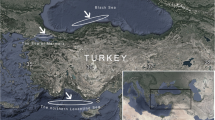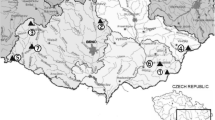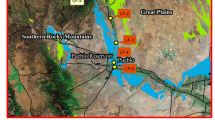Abstract
Samples of 7 species of piscivorous, omnivorous, and herbivorous fish caught at 12 different sites on the Madeira River, Amazon Basin, were analyzed for selenium and mercury. Selenium was determined by anodic stripping voltammetry and mercury by cold vapor atomic absorption spectrophotometry. The means for selenium concentrations ranged from 0.49 to 3.11 nmol/g and for mercury from 0.41 to 6.66 nmol/g depending on the fish species. The molar ratios of Hg:Se increased according to the fish trophic level. Piscivorous species had the highest mean ratio (4.0) and herbivorous species the lowest (0.9). There was a positive and statistically significant correlation between selenium and mercury concentrations for the herbivorous species (r = 0.716;p = 0.0088) not seen for omnivororus and piscivorous species (r = -0.2032;p = 0.3407). These findings are significant for the fish-eating population of the Madeira River because the ingestion of mercury would always be in excess of selenium.
Similar content being viewed by others
References
A. C. Barbosa, A. A. Boischio, G. A. East, I. Ferrari, A. Gonçalves, P. R. M. Silva, and T. M. E. Cruz, Mercury contamination in the Brazilian Amazon. Environmental and occupational aspects,Water Air Soil Poll. 80, 109–121 (1995).
A. A. Boischio, D. Henshel, and A. C. Barbosa, Mercury exposure through fish consumption by the Upper Madeira River population, Brazil—1991,Ecosyst. Health 1, 77–192 (1995).
A. C. Barbosa, S. R. L. Silva, and J. G. Dorea, Concentration of mercury in hair of indigenous mothers and infants from the Amazon basin,Arch. Contant. Toxicol. Environ. 34, 100–105 (1998).
A. C. Barbosa and J. G. Dorea, Indices of mercury contamination during breast feeding in the Amazon Basin,Environ. Toxicol. Pharmacol. 6, 71–79 (1998).
B. J. Koos and L. D. Longo, Mercury toxicity in the pregnant woman, fetus, and newborn infant,Am. J. Obstet. Gynecol. 126, 390–408 (1976).
I. Ferrari, A. GonÇalves, A. Barbosa, A. J. Centeno, A. J. Padovani, N. N. S. Gonçalves et al., InvestigaçÃo de genotoxicidade em pessoas profissionalmente expostas ao mercúrio em garimpos da Amazonia Legal. II Resultados dosimétricos e genotóxicos,Rev. Bras. Saude Ocup. 20, 101–104 (1992).
F. F. P. Branches, T. B. Erikson, S. E. Aks, and D. O. Hryhorczuk, The price of gold: mercury exposure in the Amazonian rain forest,Clin. Toxicol. 31, 295–306 (1993).
T. Leino and M. Lodenius, Human hair mercury levels in Tucuruí area, State of Pará, Brazil,Sci. Total Environ. 175, 119–125 (1995).
R. F. White, A. Nielsen, P. Grandjean, P. J. Jorgensen, D. Cleary, and E. Santos, Neuropsychological performance of methylmercury-exposed children in the Brazilian Amazon, International Conference on Human Health Effects of Mercury Exposure, Torshavn, Faroe Islands, 1997 (abstract).
X. Wu, X. Ce, H. Zhon, Y. W. Rao, A. Li, and W. J. Zhang, The antagonistic effect of selenium on the toxicity of mercury,Trace Elements Med. 7, 40–44 (1990).
J. Poupon, Selenium as pharmacological agent against heavy metal poisoning and chemical or physical carcinogenesis, inTherapeutics Uses of Trace Elements. Plenum, New York, pp. 219–224 (1996).
A. W. Glynn, N. G. Ilback, D. Brabencova, L. Carlsson, E. C. Enqvist, E. Netzel, et al, Influence of sodium selenite on203Hg absorption, distribution, and elimination in male mice exposed to methyl203Hg,Biol. Trace Element Res. 39, 91–107 (1993).
D. G. Ellingsen, R. I. Holland, Y Thomassen, M. Landro-Olstad, W. Frech, and H. Kjuus, Mercury and selenium in workers previously exposed to mercury vapour at a chloralkali plant,Br. J. Ind. Med. 50, 745–752 (1993).
D. G. Ellingsen, H. P. Nordhagen, and Y. Thomassen, Urinary selenium excretion in workers with low exposure to mercury vapour,J. Appl. Toxicol. 15, 33–36 (1995).
T. Aoi, T. Higuchi, R. Kidokoro, R. Fukumura, A. Yagi, S. Ohguchi, et al., An association of mercury with selenium in inorganic mercury intoxication,Human Toxicol. 4, 637–642 (1985).
G. Drasch, E. Wanghoffer, G. Roider, and S. Strobach, Correlation of mercury and selenium in the human kidney,J. Trace Elements Med. Biol. 10, 251–254 (1996).
L. Magos and T. W. Clarkson, Atomic absorption determination of total, inorganic and organic mercury in blood,J. Assoc. Off. Anal. Chem. 55, 966–971 (1972).
J. Burger, K. Cooper, and M. Gochfeld, Exposure assessment for heavy metal ingestion from a sport fish in Puerto Rico: estimating risk for local fishermen,J. Toxicol. Environ. Health 36, 355–365 (1992).
R. Dietz, F. Riget, and P. Johansen, Lead, cadmium, mercury and selenium in Greenland marine animals,Sci. Total Environ. 186, 67–93 (1996).
C. Leonzio, S. Focardi, and C. Fossi, Heavy metals and selenium in stranded dolphins of the northern Tyrrhenian (NW Mediterranean),Sci. Total Environ. 119, 77–84 (1992).
J. E. Koeman, W. H. M. Peeters, C. H. M. Koudstaal-Hol, P. S. Tjioe, and J. J. M. Goeij, Mercury-selenium correlation in marine mammals,Nature 245, 385–386 (1973).
T. Kari and P. Kauranen, Mercury and selenium contents of seals from fresh and brackish waters in Finland,Bull. Environ. Contamin. Toxicol. 178(19), 273–280 (1978).
H. Benemariya, H. Robberecht, and H. Deelstra, Atomic absorption spectrometric determination of zinc, copper, and selenium in fish from Lake Tanganyika, Burundi, Africa,Sci. Total Environ. 105, 73–85 (1991).
E. Sindayigaya, R. Van Cauwenberg, H. Robberecht, and H. Deelstra, Copper, zinc, manganese, iron, lead, cadmium, mercury and arsenic in fish from Lake Tanganyika, Burundi,Sci. Total Environ. 144, 103–115 (1994).
B. G. Svensson, A. Nilsson, E. Jonsson, A. Schutz, B. Akesson, and L. Hagmar, Fish consumption and exposure to persistent organochlorine compounds, mercury, selenium and methylamines among Swedish fishermen,Scand. J. Work Environ. Health. 2, 96–105 (1995).
P. Grandjean, P. Weihe, P. J. Jorgensen, T. Clarkson, E. Cernichiari, and T. Videro, Impact of maternal seafood diet on fetal exposure to mercury, selenium, and lead,Arch. Environ. Health 47, 185–195 (1992).
M. Mutanen, P. Koivistoinen, V. C. Morris, and O. A. Levander, Nutritional availability to rats of selenium in four seafoods: crab(Callinedes sapidus), oyster(Crassostrea virginica), shrimp(Penaeus duorarum) and Baltic herring(Clupea harengus), Br. J. Nutr. 55, 219–225 (1986).
H. Y. Wen, R. L. Davis, B. Shi, J. J. Chen, L. Chen, M. Boylan et al., Bioavailability of selenium from veal, chicken, beef, pork, lamb, flounder, tuna, selenomethionine, and sodium selenite assessed in selenium-deficient rats,Biol. Trace Element Res. 58, 43–53 (1997).
A. R. Alexander, P. D. Whanger, and L. T. Miller, Bioavailability to rats of selenium in various tuna and wheat products,J. Nutr. 113, 196–204 (1983).
B. O. Gabrielsen and J. Opstvedt, Availability of selenium in fish meal in comparison with soybean meal, corn gluten meal and selenomethionine relative to selenium in sodiumselenite for restoring glutathione peroxidase activity in selenium-depleted chicks,J. Nutr. 110, 1096–1100 (1980).
Author information
Authors and Affiliations
Rights and permissions
About this article
Cite this article
Dorea, J.G., Moreira, M.B., East, G. et al. Selenium and mercury concentrations in some fish species of the Madeira River, Amazon Basin, Brazil. Biol Trace Elem Res 65, 211–220 (1998). https://doi.org/10.1007/BF02789097
Received:
Accepted:
Issue Date:
DOI: https://doi.org/10.1007/BF02789097




